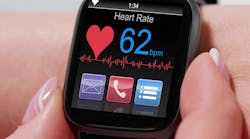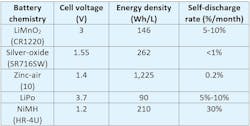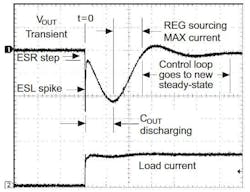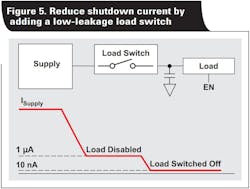Maximizing Battery Life in Medical Wearables
Members can download this article in PDF format.
What you’ll learn:
- How device-level advances extend the battery life of medical wearables.
- What tradeoffs exist between different battery chemistries in these systems.
- Considerations related to transitions from standby mode to active mode and back.
The market for wearable medical devices is rapidly expanding. Not only are more devices receiving government-standard clearance to diagnose illnesses and monitor life-critical biomarkers, but more users are interested in more personal data to improve their lifestyles. The capability to track metabolic performance, stress, and sleep quality are especially popular features sought by consumers.
Makers of wearable medical devices strive to achieve smaller size, lighter weight, longer operation times, and smarter feature sets. Often, though, these traits outpace battery advances, so designers must come up with novel ways to use batteries more efficiently, and thus increase overall functionality.
Regardless of power topology, the challenges are constant—wearable medical devices require:
- Low quiescent current (Iq) and shutdown features to increase their shelf life.
- High efficiency to extend their lifetime in active mode.
- The ability to tolerate and manage dynamic fast transient loads typical of radio transmissions.
Low-power microcontrollers (MCUs), edge artificial-intelligence (AI) processing, and analog integrated circuits (ICs) are available, but it’s not always possible to leverage these technologies in a design without optimizing power management. It’s important to choose the right power architecture for the application to increase efficiency and extend battery run times.
In this article, we’ll highlight different power schemes and new technologies in load switches, DC-DC converters, and battery chargers that can maximize battery life in disposable and reusable wearable medical devices for both shelf/ship-mode and active mode.
Types of Batteries Used in Medical Wearables
Devices such as heart-rate monitors, multiparameter patches, blood-glucose monitors, blood-pressure monitors, pulse oximeters, fitness monitors, activity monitors, and drug-delivery patches can be portable and wearable. Many of these devices are disposable or use batteries that need replacing. Furthermore, current wearable medical devices can connect to an increasing number of smart devices and support multiple protocols, resulting in higher power consumption.
Lithium-manganese-dioxide (LiMnO2), alkaline, and lithium-ion (Li-ion) batteries have been staples in wearables because of their high energy density, lifespans, and rechargeability. But recent advances in newer chemistries are now enabling new possibilities and implementations. Silver-zinc and zinc-air allow for longer active-mode capacities, while silver-oxide adds low self-discharge rates of approximately 10% a year or less, leading to a longer shelf life.
There are also new developments in rechargeable battery technologies. Li-polymer (LiPo) batteries allow for flexible battery designs that can be molded to small wearables. And solid-state batteries are becoming affordable enough to implement into wearables, bringing high energy densities and flexible form factors without safety concerns. Nickel metal hydride (NiMH) remains popular for continuous use and long lifetimes at a lower cost. Low-discharge-rate NiMH is available, too.
One trend with high-energy-density battery chemistries is to lower cell voltages (Table 1), which requires power solutions operating at higher efficiencies without high headroom under peak loads. Unfortunately, the high peak currents, from functions like RF data transmission or turning on a motor, could cause the battery voltage to dip low enough to trigger brownout for critical ICs.
Designers must carefully select the battery chemistry based on several system-level requirements, while also complying with safety and regulatory standards. One example of a tradeoff is optimizing batteries with different AC and DC internal impedances for applications with specific high or low drain profiles while balancing the self-discharge rate based on the wearable’s expected lifetime. For disposable wearables, low self-discharge is an important requirement versus rechargeable wearables.
Optimizing Active and Standby Mode Transitions in Wearable Medical Devices
While in active mode, medical patches (electrocardiograms, temperature, and glucose) will typically spend a short amount of time to take a measurement, process or pre-process the data to send to a remote terminal, and then go back to sleep. In this situation, the batteries see loads quickly transitioning from hundreds of nanoamperes to a few tens of milliamperes in sensing patches, or even higher currents for drug-delivery patches with motors and pumps.
Such a scenario is shown in Figure 1, where a step load in the bottom waveform causes large voltage transients in the main supply line shown in the top waveform. The primary challenge is when systems that can operate efficiently across different loads also must handle transients as fast as a few microseconds.
Consider the example in Figure 2, which illustrates the use of Texas Instruments’ (TI) CC2340R5 Bluetooth Low Energy (LE) MCU with a low-voltage battery chemistry in a wearable application. Because the input voltage of the Bluetooth LE device only goes down to 1.7 V, you can use a boost converter (for example, TI’s TPS61299).
Typically, as the Bluetooth LE device goes from sleep mode to a connection event, the load currents will increase very rapidly and cause a large voltage dip at the main supply rail. This is especially the case when using a battery chemistry with high equivalent series resistance and equivalent series inductance. To sustain these dips and not have parts of the circuit go into brownout, devices like the TPS61299 incorporate a fast-mode detection control loop that can stabilize the supply voltage and reduce settling times down to 8 µs for typical Bluetooth LE loads.
In applications like insulin pumps and drug-delivery patches, the load transients from the dosing pumps might be too high for traditional compensation methods. In this scenario, large supercapacitors can quickly provide the energy needed by high-drain components. TI’s TPS61094 is a 60-nA IQ buck-boost converter with supercapacitor management that seamlessly transitions between battery and supercapacitor power.
In addition to solving transient response challenges, it’s imperative to achieve high efficiency across multiple decades of current loads. TI’s DC-DC switching regulator portfolio has several devices designed to address specific challenges present in wearable medical devices.
Pass-through mode allows for buck, boost, and buck-boost devices to connect the load directly to the battery when the input voltage closely matches the chosen output for improved operational efficiency. As the voltage drops, the devices will go into active mode and have several modes of operation. Intelligent switching between pulse-width modulation (PWM), pulse frequency mode (PFM), and burst mode as the load changes from high to low helps the overall system efficiency stay above 85%, from microampere levels to hundreds of milliamperes.
Besides automatically changing between PWM and PFM, TI’s TPS62840 buck converter has a 100% PWM mode that only draws 120 nA of IQ. This lets the system keep operating with high maximum efficiency even when the battery is near depletion.
Another way to solve the transient problem is to increase efficiency during both low and high current modes. TI’s TPS63900 buck-boost converter has two different programmable voltages. For example, the device can boost to 3 V as the CC2340R5 is about to wake up, thus enabling the radio to operate more efficiently. The converter can then drop to 1.8 V in standby mode when only a few IC blocks are turned on.
Table 2 lists the devices mentioned in this section along with their unique current consumptions in different modes.
Prolonging Battery Life Through Low-Power Ship Mode and Smart Load Switches
Most wearable medical devices aren’t active while packaged because weeks or months can pass before they make their way to the user (or patient). A dedicated low-power mode helps preserve battery life while the product travels from the manufacturer to the consumer.
In what is also known as “ship mode,” the device is placed in a high impedance state and current leakage is effectively suppressed. Only a few extremely low-Iq devices remain powered in ship mode to detect when the device will begin active use.
In addition, a ship mode with minimal shutdown currents helps maximize the power available when the product eventually goes into active use. This becomes exceptionally important if the device is designed to work with disposable batteries.
Consider an example of a wireless patch using a 1.5-V silver-oxide battery with 150 mAh of capacity. To last a year while inactive, a wearable medical device could use a load switch to minimize current consumption. If the product’s system components draw approximately 1 µA when disabled, that amount is consuming at least 8.76 mAh (1 µA × 24 hours × 365 days) of the 150-mAh budget.
In other words, device inefficiencies could contribute around 5.84% (8.76 mAh/150 mAh) to overall battery loss. These inefficiencies may originate from losses such as minimum and maximum specifications over temperature, efficiency loss through the power components, and radio modules leaking current.
Devices such as load switches with shutdown currents down to nanoampere ranges help save power over long periods. Load switches work as electrically controlled switches, capable of significantly decreasing current from the supply when a module doesn’t need to be active (Fig. 3).
A load switch like the TPS22916 (0.8 × 0.8 mm) can cut the shutdown leakage current down to 10 nA, an amount that will have virtually no effect (0.058%) on battery life while the system is disabled (Table 3).
If there are multiple individually powered modules in a single product, it’s possible to have more than one load switch disable individual loads and modules. This increases the power architecture’s ability to tightly manage power consumption on an as-needed basis.
Other integrated low-Iq devices include DC-DC converters with shutdown features such as true disconnect, which can minimize leakage currents to prevent power losses during shutdown. Most DC-DC converters can now reach shutdown currents of 60 nA or lower, which facilitates device selection and reduces cost by eliminating the need for an additional load switch IC. Although not always as effective as a load switch, the ability of a DC-DC converter to act as a load switch may be the deciding factor when size is an important consideration.
Getting Charge into Batteries
Battery charging for wearable medical devices is a challenging subject because batteries in these products must be small in both size and capacity. Charge currents and patterns vary greatly depending on battery capacity and chemistry. The ability to charge wirelessly also introduces a higher level of complexity.
While it’s important to charge quickly, it’s also crucial to get as much energy into the battery as possible. This can be accomplished with specific techniques such as low termination current and careful monitoring of the battery level. Maximizing the charge of each battery cycle is achievable through careful selection of devices designed for the specific application.
Although disposable wearables are most common right now, the convenience of reusability is important to consumers, who prefer fast charging with a wireless charger or easily attachable cable. Environmental considerations also drive the transition toward more rechargeable devices for their reusability.
One major advantage of battery-charging devices is their high level of integration. It’s possible to employ varying levels of power integration, depending on a design’s available space and power needs. Battery-charge-management solutions for wearables such as TI’s BQ25125 (2.5 × 2.5 mm) and the BQ25155 (2 × 1.6 mm) can provide efficient battery current draw by integrating various power solutions into one small chip.
Useful features such as integrated ship mode and low-Iq DC-DC converters further preserve battery life. Battery monitoring is also very accurate in these devices, which can help in the design of more efficient systems.
There are multiple ways to improve battery life in wearable patient monitors and medical patches. The key to long battery life is to select devices that operate with the lowest current consumption and effectively reduce system activity to when it’s not needed. The power architecture plays a significant role in achieving longer battery life.








